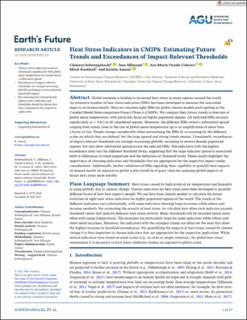| dc.description.abstract | Global warming is leading to increased heat stress in many regions around the world.
An extensive number of heat stress indicators (HSIs) has been developed to measure the associated
impacts on human health. Here we calculate eight HSIs for global climate models participating in the
Coupled Model Intercomparison Project Phase 6 (CMIP6). We compare their future trends as function of
global mean temperature, with particular focus on highly populated regions. All analyzed HSIs increase
significantly (p < 0.01) in all considered regions. Moreover, the different HSIs reveal a substantial spread
ranging from trends close to the rate of global mean temperature up to an amplification of more than
a factor of two. Trends change considerably when normalizing the HSIs by accounting for the different
scales on which they are defined, but the large spread and strong trends remain. Consistently, exceedances of impact-relevant thresholds are strongly increasing globally, including in several densely populated regions, but also show substantial spread across the selected HSIs. The indicators with the highest exceedance rates vary for different threshold levels, suggesting that the large indicator spread is associated both to differences in trend magnitude and the definition of threshold levels. These results highlight the importance of choosing indicators and thresholds that are appropriate for the respective impact under consideration. Additionally, further validation of HSIs regarding their capability to quantify heat impacts on human health on regional-to-global scales would be of great value for assessing global impacts of future heat stress more reliably. | en_US |

